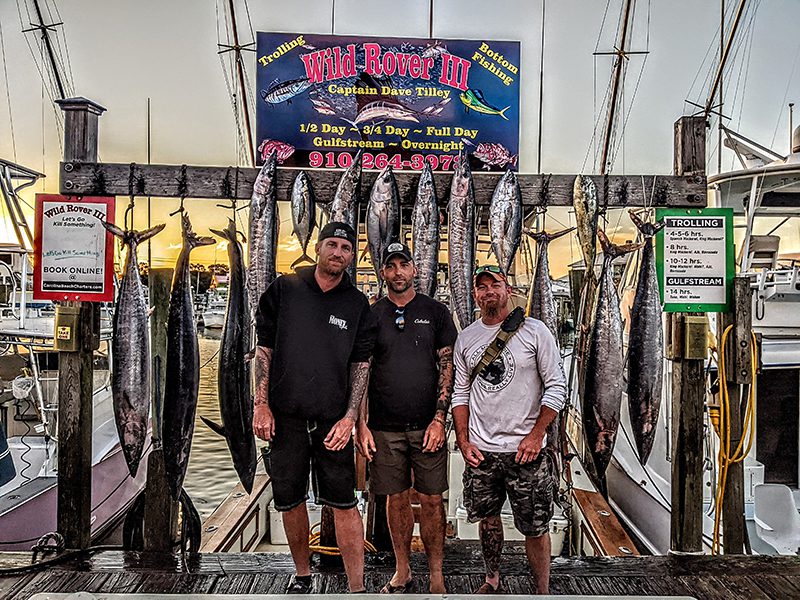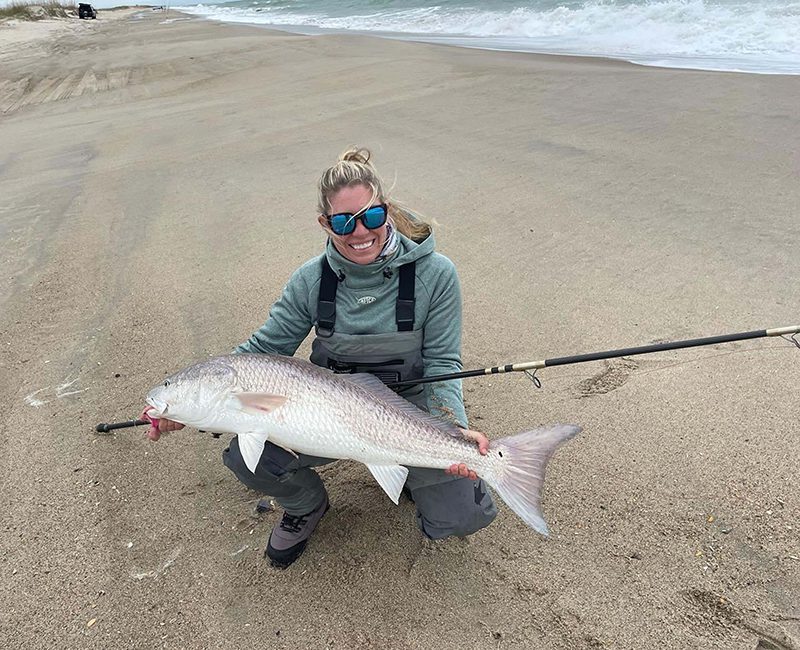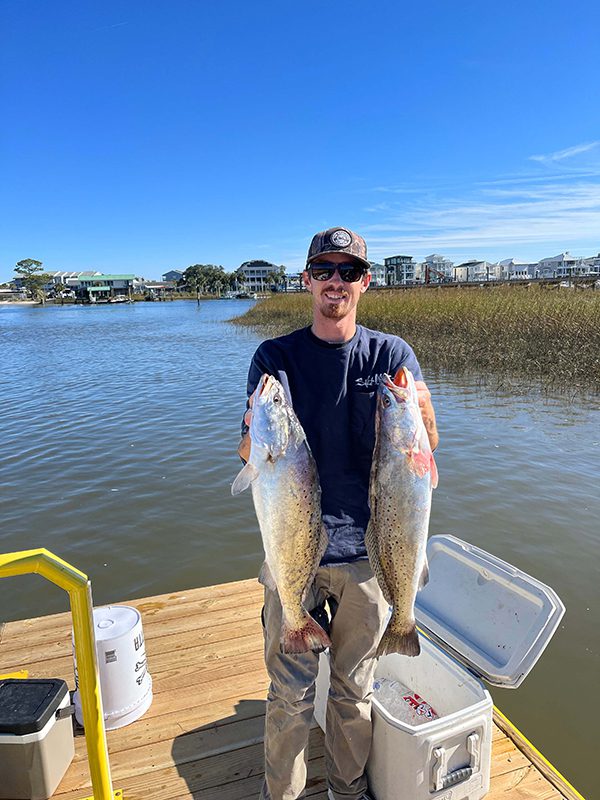Carolina Beach – December 2022
Lewis, of Island Tackle and Hardware, reports that surf anglers have been having success hooking whiting, pufferfish, sharks, a few bluefish, and scattered speckled trout.
Fishing in the river has been steady, with anglers finding red drum, black drum, and speckled trout action all picking up with the cooling water temperatures getting the fish more schooled up.
Anglers fishing structured areas upriver are starting to get into the striped bass bite.
King mackerel and most of the bottom fishing action is coming from structure in the 35-mile range.
Gulf Stream runs are producing nice-sized blackfin tuna and wahoo.

Brian Owens, Brent Connor, and Jessie McCarty landed ten wahoo, two blackfin tuna, one yellowfin tuna, and one mahi. They were fishing 65 miles off of Carolina Beach with Capt. Dave Tilley on the Wild Rover III.
Christian, of Seahawk Inshore Fishing Charters, reports that anglers have started to move their focus to red drum fishing. Scented soft plastics from Z-Man or Gulp work best for anglers fishing artificials. Carolina-rigged mud minnows and dead shrimp will also produce strikes, especially on days that the winds don’t allow for proper casting techniques. Most of these winter reds are a smaller (16-17”) class, with slot-sized fish scattered in.
Anglers will also be finding black drum throughout these cooler months. Fishing with dead shrimp will attract bites from what are typically 14-16” fish, and groups of these fish will be staged up in deeper holes throughout the creeks and near hard structures. Lower tide cycles will see the best feeding action.
Luke, of Spot On Charters, reports that fall fishing started to kick off with a strong trout bite, but that bite has since has been slowed down by the late fall run of warmer weather. Anglers were seeing some nice-sized fish earlier, and now that water temperatures are coming back down, they hope to see the quality of fish increase.
Most trips have found the trout staged up on opposite spectrums of the river, with some well downriver and closer to the inlet, with another group well up towards downtown. Most MirrOlure MR-17s and soft plastics have enticed strikes, and this trout bite should stick around until water temperatures get too cool and fishing requires super slow tactics and plenty of patience.

Teresa Young, of Wilmington, caught (and released) this 42″ red drum on cut sea mullet fishing from the Fort Fisher surf.
Tommy, of Mungo Fishing Charters, reports that as these cooler winter months come around, it is time to shift gears into targeting the schooling red drum. Anglers should start to utilize sight-casting techniques while looking for these reds in the shallower flats and bays. A Gulp shrimp rigged on lightly weighted jig heads will work fine as long as you approach the fish without spooking the school.
Black drum fishing has been solid, and the bite will continue throughout most of the winter months. Fresh dead shrimp fished around hard structures such as rocks, pilings, and oyster bars will hold most of these groups of black drum.
Mason, of Grand Slam Fishing Charters, reports that anglers are starting to see red drum migrating back into their winter patterns and holes. On days you have sun, these redfish can be found schooling on the flats. The wintertime clear water conditions can have these schools really spooky, so approaches and presentations are important. Both Gulp soft plastics and live shrimp or mud minnows are productive baits for this fishery, and look for red drum to also be caught throughout the mainland creeks. Typically, the reds will be staged in deeper holes with a shelly bottom. Most times these are schools of fish, so catching one tends to mean there are likely more around.
Black drum will be found in similar holes throughout the winter, and both drum species can be caught with bottom-rigged live mud minnows or fresh shrimp.
Speckled trout fishing can be very good in these first early weeks of winter. Anglers are having success targeting points, eddies, and current seams for these trout schools. Finding a nice ledge near hard bottom with moving water is another great place to start casting for trout.
A live shrimp rigged on a #4 treble under a Billy Bay cork has been a top producing setup for the trout. There have also been hookups on slow sinking artificial baits such as MirrOlure MR-17s and D.O.A. shrimp.

Capt. Mason Porter, of Grand Slam Inshore Fishing Charters, landed these 25″ speckled trout while floating live shrimp under a cork in the Cape Fear River.
Rod, of OnMyWay Fishing Charters, reports that early winter is a great time for running out to fish live bottoms and ledges in the 10+ mile range. Fishing there has been excellent on larger black sea bass and some gag grouper.
Out a bit further in the 25-35 mile range, anglers are also finding vermilion snapper, huge grunts, pinkies, and gatsby grouper.
There are kings around, but they are pushing their way off, being sure to hold in that low to mid 70-degree temperature range. Going into the winter, it will be best to look at current SST charts for the right temps, which will probably be out near Frying Pan Tower.
Making the run out to the break has also been very productive. Wahoo fishing has been good, and they’re being caught alongside blackfin tuna, a few mahi, and king mackerel. Be sure when targeting wahoo to really focus on the rocks and bottom structure. These wahoo packs will almost certainly be holding to structure, especially when water temperatures hang in the 70-74 degree range. Get your Blue Water Candy with rigged ballyhoo setups down deep, and this means generally 40-60’ down. Many times there will be schools of false albacore out there as well, so you want your baits to be running beneath them.
Moving deeper into winter, there are still great fishing opportunities for anglers looking to take advantage of the weather windows. Jumbo black sea bass make up one of those species that makes it worthwhile to go wet a line, and December through March is the best time for these fish to be actively feeding on bottoms in the 18-24 mile range.
Jackson, of Kure Beach Pier, reports that anglers getting out on the planks for the end of the season were catching some whiting.
